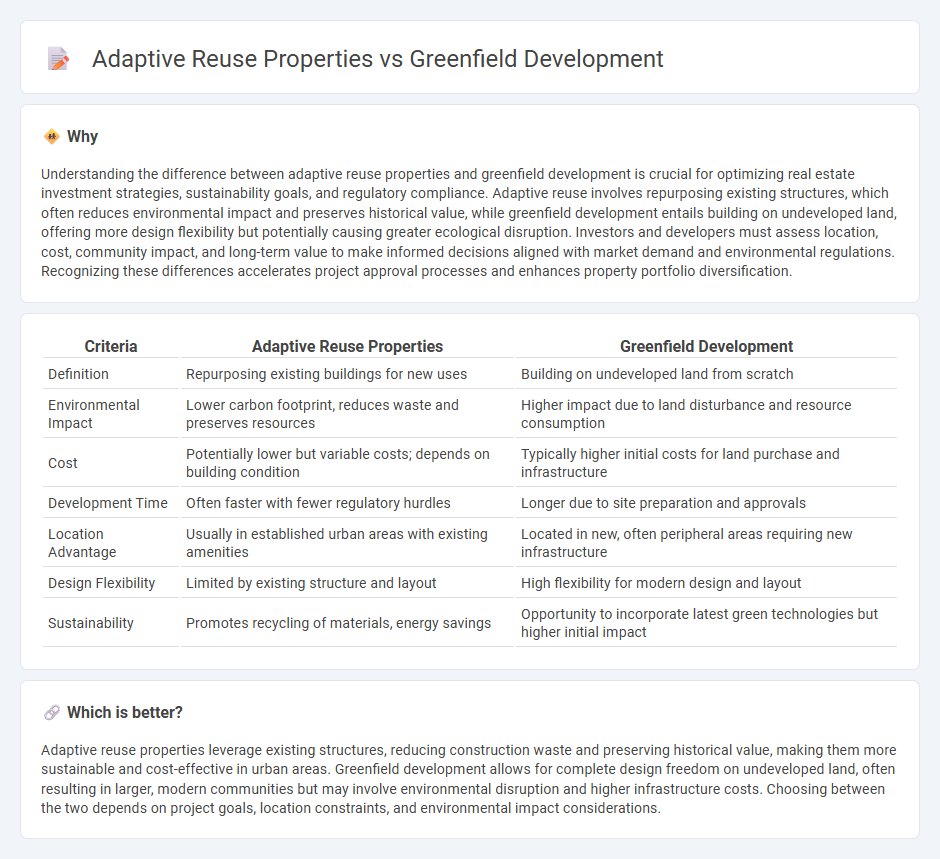
Adaptive reuse properties transform existing buildings into functional spaces, reducing environmental impact by preserving materials and minimizing construction waste. Greenfield development involves constructing new projects on previously undeveloped land, often resulting in habitat disruption but allowing for modern, customized designs. Explore the benefits and challenges of both approaches to make informed real estate decisions.
Why it is important
Understanding the difference between adaptive reuse properties and greenfield development is crucial for optimizing real estate investment strategies, sustainability goals, and regulatory compliance. Adaptive reuse involves repurposing existing structures, which often reduces environmental impact and preserves historical value, while greenfield development entails building on undeveloped land, offering more design flexibility but potentially causing greater ecological disruption. Investors and developers must assess location, cost, community impact, and long-term value to make informed decisions aligned with market demand and environmental regulations. Recognizing these differences accelerates project approval processes and enhances property portfolio diversification.
Comparison Table
| Criteria | Adaptive Reuse Properties | Greenfield Development |
|---|---|---|
| Definition | Repurposing existing buildings for new uses | Building on undeveloped land from scratch |
| Environmental Impact | Lower carbon footprint, reduces waste and preserves resources | Higher impact due to land disturbance and resource consumption |
| Cost | Potentially lower but variable costs; depends on building condition | Typically higher initial costs for land purchase and infrastructure |
| Development Time | Often faster with fewer regulatory hurdles | Longer due to site preparation and approvals |
| Location Advantage | Usually in established urban areas with existing amenities | Located in new, often peripheral areas requiring new infrastructure |
| Design Flexibility | Limited by existing structure and layout | High flexibility for modern design and layout |
| Sustainability | Promotes recycling of materials, energy savings | Opportunity to incorporate latest green technologies but higher initial impact |
Which is better?
Adaptive reuse properties leverage existing structures, reducing construction waste and preserving historical value, making them more sustainable and cost-effective in urban areas. Greenfield development allows for complete design freedom on undeveloped land, often resulting in larger, modern communities but may involve environmental disruption and higher infrastructure costs. Choosing between the two depends on project goals, location constraints, and environmental impact considerations.
Connection
Adaptive reuse properties and greenfield development intersect through their roles in sustainable real estate strategies, with adaptive reuse revitalizing existing structures to reduce environmental impact, while greenfield development introduces new construction on previously undeveloped land. Both approaches influence urban planning and land use efficiency, balancing preservation with expansion to meet housing and commercial demands. Integrating adaptive reuse within greenfield projects can optimize resource utilization, lower carbon footprints, and enhance community value by blending historical context with modern development.
Key Terms
Land acquisition
Greenfield development involves acquiring undeveloped land, often requiring extensive site preparation and infrastructure investment, whereas adaptive reuse focuses on repurposing existing buildings, minimizing new land acquisition costs. Land acquisition for greenfield projects can be more expensive due to zoning, environmental regulations, and potential community opposition. Explore detailed comparisons on land acquisition strategies and financial implications between greenfield and adaptive reuse projects.
Zoning regulations
Zoning regulations play a critical role in Greenfield development by determining permissible land uses, building heights, densities, and setbacks, often allowing greater design flexibility on undeveloped land. Adaptive reuse properties face more complex zoning challenges, as regulations must accommodate changes in use while preserving historic or existing structures, frequently requiring variances or special permits. Explore detailed insights on how zoning impacts both development types to navigate regulatory landscapes effectively.
Environmental impact
Greenfield development involves constructing on previously undeveloped land, often leading to habitat disruption and increased carbon emissions due to land clearing and infrastructure demands. Adaptive reuse properties repurpose existing structures, significantly reducing construction waste, preserving embodied energy, and minimizing resource consumption. Explore detailed comparisons of environmental impacts to make informed real estate and sustainability decisions.
Source and External Links
What Is Greenfield Development? | Planopedia - Planetizen - Greenfield development refers to real estate projects built on previously undeveloped land, offering opportunities free from constraints typical of redeveloping existing sites and allowing practical and affordable construction.
A Guide to Greenfield Development (2023) - Transect - Greenfield development involves building on undeveloped urban or rural land, characterized by fewer development hurdles, faster timelines, and flexibility compared to brownfield redevelopment, though it may contribute to urban sprawl.
Greenfield Development: Building from Scratch for a Sustainable Future - Greenfield development provides a blank slate that enables incorporation of innovative sustainable design, efficient land use, and infrastructure planning, supporting environmentally friendly and energy-efficient communities from the outset.
 dowidth.com
dowidth.com